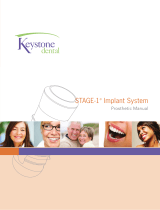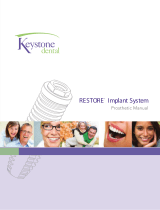
Rx Only—product is intended for use by a licensed dental professional.
For Safety Data Sheet (SDS) go to www.parkell.com.
Description:
Predicta Bioactive Cement is an easy-to-use, self-adhesive, bioactive,
radiopaque, dual-cure, strong permanent cement. The cement’s high bond
strength to dentin and enamel eliminates the need for a separate bonding
agent, which simplies the cementation proce ss. Predicta® Bioactive Cement
lls and seals mic r o gaps with robust hydrox yapatite formation at the margin,
and thereby alleviates or prevents microleakage, which is otherwise
associated with recurrent decay.1 By combining all the properties and
performance benets of premium universal resin cements with bioactivity, it
gives crown margins unprecedented protection against secondary caries.
Indications for Use:
Predicta Bioactive Cement is intended for the cementation of indirect
restoratives, including ceramic, zirconia, composite, and metal-based inlays,
onlays, crowns, bridges, and posts.
Technical Information:
Indirect Restoratives (e.g., Crowns, Bridges)
• Work Time: 1 minute at room temperature
• Set Time (Self-cure): 4 – 5 minutes from start of mixing
at mouth temperature.
• Set Time (Light-cure): 20 seconds
(direct exposure at restoration margin)
Post Cementations
• Work Time: Direct placement in the mouth will reduce worktime. The
actual decrease can vary (sometimes signicantly) based on patient’s
mouth temperature at the treatment site.
• Set Time (Self-cure): 4 – 5 minutes from start of mixing
at mouth temperature.
• Set Time (Light-cure): 20 seconds (for post stabilization at the orice.
Depth of cure will depend on access and intensity of light.)
Important Tips for Best Results:
• Ability to light-cure under restorations is dependent on the translucency
of the restoration and the intensity of the curing light.
•
Onset of self-cure gel phase will be dependent on how long it takes for the
restoration to be seated in the mouth as well as the mouth temperature of
the patient.
•
Phosphate contamination of zirconia restorations from saliva during try-in
will impact adhesion. Always consult with the lab or the manufacturer of
the zirconia on how best to clean the intaglio.
• If refrigerated, always bring to room temperature before use.
•
Curing Light Minimum Requirements: Blue-light emitting at 430 – 480 nm,
with a minimum intensity of 600mW/cm2.
Contraindications:
• Patients with a history of sensitivity to this product.
• Not for use on or by persons who are methacrylate sensitive.
• Not for use as a veneer cement.
Precautions:
• Protect the patient’s eyes when using all dental materials.
• For dental use only.
• Keep all components away from children.
• Contact between Predicta Bioactive Cement and sensitive, or inamed
soft tissues (mucosa, eyes, nose, and the like), may cause irritation,
dermatitis, and/or inammatory re a c tions. If this occur s, discontinue use,
ush area with copious amounts of water, and consult a physician.
• Use a rubber dam or other suitable isolation methods to prevent
contamination of surfaces.
•
Do not apply eugenol containing products to any surface prior to or during
cementation. They will reduce the ecacy of the cement.
Instructions for Cementation of Crowns, Bridges,
Inlays and Onlays:
1. Prepare restorative surfaces for bonding to Cement.
a.
Metal Surfaces: Cement bonds to non-precious metal alloys without
special pretreatment other than microetching (sandblasting with
50-micron aluminum oxide). The durability of the bond to precious and
noble dental alloys can be signicantly improved by sandblasting the
metal surface and priming it with a metal primer such as Parkell’s MTL-V
Primer™ or Parkell’s Brush&Bond® MAX. (Both available separately).
b. Porcelain & Lithium Disilicate Surfaces: Cement will bond well to
hydrouoric acid-etched porcelain or lithium disilicate surfaces that
have been primed with Parkell’s Ea-Z-Y Primer™ (available separately)
or any silane containing ceramic primer. (Important: Laboratory or
dental manufacturer’s instructions for pre-treatment always
take precedence.)
c. Zirconia Surfaces: Cement will bond well to sandblasted zirconia
surfaces without the need of an additional primer. For cases where
additional retention may be a benet, an MDP containing Zirconia
primer such as Parkell's Ea-Z-Y Primer is recommended. (Important:
Laboratory or dental manufacturer’s instructions for
pre-treatment always take precedence.)
2. Remove temporary restoration and clean o remaining temporary
cement and debris from tooth. Prepare the surface for cementation,
using appropriate cleaners and disinfectants.
3. Rinse the preparation with water and lightly dry with air or cotton. Do
not desiccate the tooth.
4. (Optional) Apply releasing agent such as Parkell’s BluSep™ (available
separately) to non-bonded surfaces to simplify post-insertion clean up
and cement removal.
5. Priming the tooth surface is not required as the cement will adhere to
appropriately cleaned untreated enamel and dentin on its own. For less
retentive preps, where additional adhesion may be benecial, a bonding
agent that is dual-cure compatible can be applied to enamel and dentin
as per the manufacturer’s instructions.
6. Remove the cap from the cement syringe (do not discard as it will be
used later to recap and reseal the cartridge) and bleed enough out to
assure that cement is dispe nsing from both orices of the syringe. Attach
the 1:1 straight mixing tip that came with the cement onto the syringe,
bleed a small amount of cement onto a pad through the tip to ensure an
even mix, and immediately dispense directly into the restoration.
7.
Fully seat restoration onto prep allowing excess cement to extrude from
all margins. Hold restoration in place while gently removing gross excess
while it is still soft.
• Self-cure only ash removal: While maintaining pressure on the
restoration, continue to check the ash with an explorer for the onset
of the gel phase, at which time the cement will easily peel away from
the margin. (Onset of gel phase will vary based on the factors
mentioned in the “Important Tips for Best Results” section above.
• Tack cure ash removal: Using a curing light, expose the marginal ash
for 1-2 seconds. The excess cement will now be partially polymerized for
easier removal. (Important: Overexposure, or use of a higher-powered
curing light will result in a more advanced polymerization of the
cement, which will make it harder and more dicult to remove.)
8.
Continue to maintain consistent pressure on the restoration until the 4-5
minutes for total set time has elapsed before nal cleanup and occlusal
adjustment. This nal cure time may be shortened for translucent
restorations by exposing all surfaces (facial, lingual, occlusal, mesial,
Self-Adhesive Resin Cement (h S630, S631)
Instructions for Use
Parkell, Inc.,
300 Executive Dr., Edgewood, NY 11717 USA
(800) 243-7446 • www.parkell.com
1. Based on multiple in vitro university studies.
A01167revA0422







